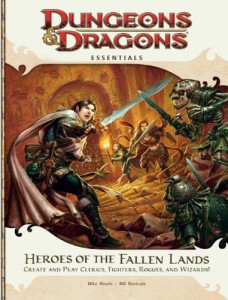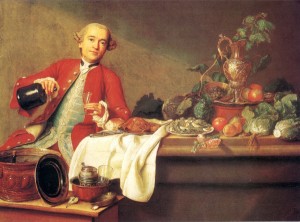Oops… somehow during our Red Box liveblog, we wrote a post about the Essentials fighter and never published it! Might as well post it now…
On my first time through Essentials character creation, I’m playing a fighter. A green-skinned fighter with rainbow hair. In my first combat, I learn about standard, move, and minor actions, hit rolls, defenses, and damage rolls (not that damage matters, because my opponents are minions). I’m also told about my fighter stances, Poised Assault and Battle Fury. The game tells me that in this case, I really should use Poised Assault. And that’s the end of the tactical thinking. The fighter path is the simplest of the paths. There are no tactical or power decisions to make. However, the fighter path has one difference from the other three classes: it’s possible to die.
The Wizard, Rogue and Cleric paths last a few rounds, max, so you’re guaranteed to win before you can possibly accumulate enough damage to die. The fighter, though, keeps on exchanging attacks with his goblin minion opponent until one of them dies. The goblin minion’s chances of victory are slim, but they are there: D&D joins Space Opera and Traveller as games in which a character can die during character creation.
Note that if you are reduced to 0 HP, you don’t technically die, you “lose consciousness”. You don’t wake up, though: you start the CYOA over, just as if you had died. The unconsciousness/death text-block admonishes you to “make sure you are using all the right numbers for your attack bonus and defenses”, because, honestly, you died against a minion?
To be fair, you probably wouldn’t die, since presumably the other members of the party are around to help you maybe! And you’d have to fail THREE saving throws before someone came around and made a DC 10 heal check to trigger your second wind and bring you back into the fight. And it would be a cruel DM who would have the goblin minion repeatedly coup de grace you to kill you before you’ve even really started playing the game. That would take 3 coup de graces!
I do like that they deal with the possibility of going unconscious, especially since they explain that going unconscious isn’t the same as dying and dying isn’t even necessarily permanent!
So Essentials: Heroes of the Fallen Lands should be available at some stores tomorrow! If I can pick one up, I might live-blog it if I get it. Check out blogofholding.com over the weekend.
More Red Box thoughts…









